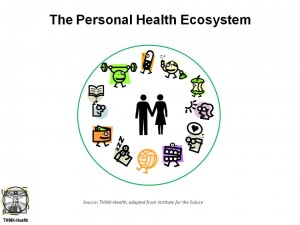 I’m talking today at the 2011 Annual PPO Forum held by the American Association of Preferred Provider Organizations (AAPPO) on the track called, “Technology Changing the Face of Health Care: What Does 21st Century Care Look Like?”
I’m talking today at the 2011 Annual PPO Forum held by the American Association of Preferred Provider Organizations (AAPPO) on the track called, “Technology Changing the Face of Health Care: What Does 21st Century Care Look Like?”
It looks like consumers connecting for health, which is the topic of my discussion.
People already DIY-many aspects of daily living online, from financial management through Schwab and eTrade online to buying travel via Priceline and shopping for shoes on Zappos. A growing number of health citizens are engaging with health online — way past the tipping point for health search online, as Susannah Fox and data from the Pew Internet & American Life Project point out.
The chart, adapted from a paradigm developed by Institute for the Future several years ago, illustrates the personal health ecosystem. In short, each of us project manages our health in our own unique way: from exercise and food choices to spiritual lives, seeing doctors, taking medicines (or not) — whether Rx or OTC — and getting sufficient sleep.
Each of these choices represents a touchpoint throughout the person’s day that can bolster health…or not. What connecting for health can do is to support a person in making that choice for health, seeing it through, and connecting the activity to a database that helps inform positive health choices ongoing. That connection can often be to a clinician, health coach, or trusted health advisor (such as a diabetes educator, nurse practitioner, or cardiologist). Ideally, the data should get automatically populated into an electronic health record and personal health record for both clinician and person to track over time. In doing so, people can manage existing chronic conditions like high blood pressure and diabetes, or stay well.
Consumers already use electronic platforms for connecting for health: their mobile phones, broadband and cable connections at home, and small devices like the FitBit which tracks activities, calories, sleep, and water intake.
I’ll talk about some of these consumer-facing connecting devices, such as the Telcare/Qualcomm Glucometer, the BodyMedia FIT Armband, the Withings scale that connects with the Panasonic VIERA HDTV, DigiFit‘s Facebook application, Tweet What You Eat, and exer-gaming examples WiiFit and The Biggest Loser Kinect game.
Health Populi’s Hot Points: What are the implications for health plans? First, lack of health engagement leads to worse health outcomes. Worse outcomes drive medical spending, which plans’ customers — employers and other plan sponsors — are trying to slow.
Beyond consumer couch potato syndrome, health plans face a distrustful public – plans and employers aren’t particularly trusted sources of health engagement for people, based on survey data from Edelman and Harris Interactive. Who is trusted as partners for health engagement? Physicians, professional medical associations and societies, nurses, pharmacies, and grocery stores. Think about the personal health ecosystem and the many trusted partners that are touchpoints in a consumer’s daily life. That’s where health plans can come together with employers in community-based hubs for connected health.




 I'm in amazing company here with other #digitalhealth innovators, thinkers and doers. Thank you to Cristian Cortez Fernandez and Zallud for this recognition; I'm grateful.
I'm in amazing company here with other #digitalhealth innovators, thinkers and doers. Thank you to Cristian Cortez Fernandez and Zallud for this recognition; I'm grateful. Jane was named as a member of the AHIP 2024 Advisory Board, joining some valued colleagues to prepare for the challenges and opportunities facing health plans, systems, and other industry stakeholders.
Jane was named as a member of the AHIP 2024 Advisory Board, joining some valued colleagues to prepare for the challenges and opportunities facing health plans, systems, and other industry stakeholders.  Join Jane at AHIP's annual meeting in Las Vegas: I'll be speaking, moderating a panel, and providing thought leadership on health consumers and bolstering equity, empowerment, and self-care.
Join Jane at AHIP's annual meeting in Las Vegas: I'll be speaking, moderating a panel, and providing thought leadership on health consumers and bolstering equity, empowerment, and self-care.